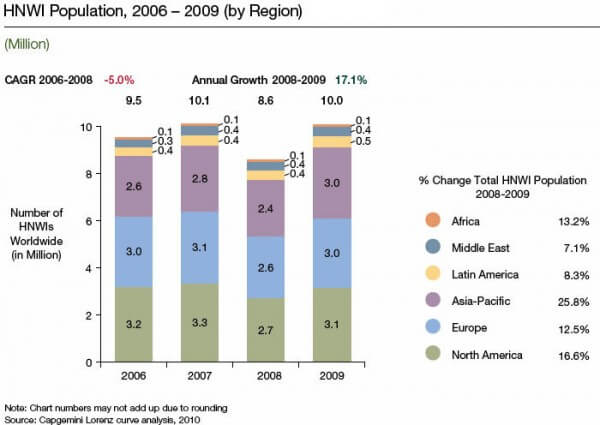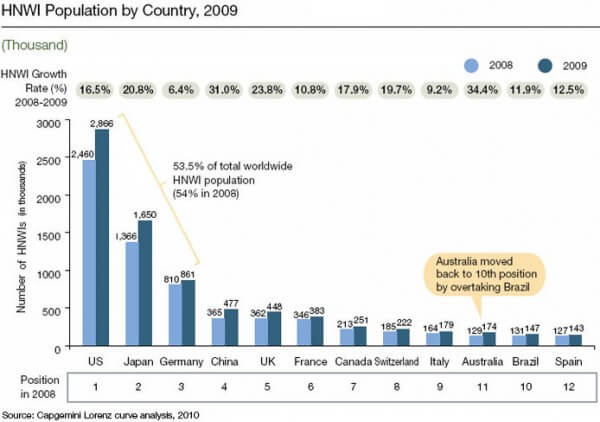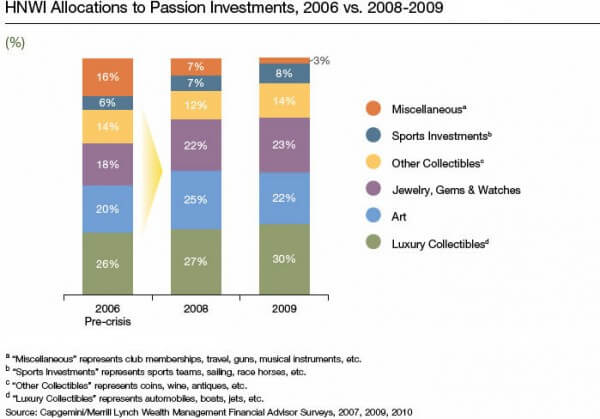En route for Asia! The luxury industry’s rallying cry seems fully justified in view of the findings of the latest World Wealth Report, published by Merrill Lynch and Capgemini. The world’s biggest fortunes – the High Net Worth Individuals (HNWIs) who hold at least US$1 million in investable assets excluding their primary residence – will soon be more numerous in Asia than in Europe and even North America. The 2008 financial crisis appears to be little more than a distant memory for the world’s wealthiest, who recovered the bulk of their fortune last year. For one main reason: the world’s stock markets surged 49% in 2009 with a subsequent rebound in financial assets. “The return to better economic conditions has almost erased losses sustained in 2008 to return to 2007 levels,” observed Gilles Dard, head of wealth management for Continental Europe at Merrill Lynch

Emerging countries lead the way
However, these “better conditions” have not been the same for all. While Europe and North America fell into recession, the Asian emerging economies continued to grow, enabling Asia to catch up with the other two continents. Consequently, the population of HNWIs is virtually identical in all three regions. North America, with 3.1 million HNWIs, is now just a whisker ahead of the other two, each with 3 million. And the situation looks set to change, as Asia-Pacific HNWIs’ wealth already surpasses that of their European counterparts. Highlights from the report are given below:
- The world’s population of HNWIs grew 17.1% to 10.0 million in 2009, returning to levels last seen in 2007 despite the contraction in world gross domestic product (GDP). Global HNWI wealth similarly recovered, rising 18.9% to US$39.0 trillion, with HNWI wealth in Asia-Pacific and Latin America actually surpassing levels last seen at the end of 2007.
- For the first time ever, the size of the HNWI population in Asia-Pacific was as large as that of Europe (at 3.0 million). This shift in the rankings occurred because HNWI gains in Europe, while sizeable, were far less than those in Asia-Pacific, where the region’s economies saw continued robust growth in both economic and market drivers of wealth.
- The wealth of Asia-Pacific HNWIs stood at US$9.7 trillion by the end of 2009, up 30.9%, and above the US$9.5 trillion in wealth held by Europe’s HNWIs. Among Asia-Pacific markets, Hong Kong and India led the pack, rebounding from mammoth declines in their HNWI bases and wealth in 2008 amid an outsized resurgence in their stock markets.
- The global HNWI population nevertheless remains highly concentrated. The U.S., Japan and Germany still accounted for 53.5% of the world’s HNWI population at the end of 2009, down only slightly from 54.0% in 2008. Australia became the tenth largest home to HNWIs, after overtaking Brazil, due to a considerable rebound.
- After losing 24.0% in 2008, Ultra-HNWIs saw wealth rebound 21.5% in 2009. At the end of 2009, Ultra-HNWIs accounted for 35.5% of global HNWI wealth, up from 34.7%, while representing only 0.9% of the global HNWI population, the same as in 2008.

These figures illustrate a major underlying trend: the explosion of emerging markets. As proof, HNWIs are investing less in Europe and North America and shifting to Asia and Latin America instead. “North Americans and Europeans are beginning to reduce their home-region investments. They are looking for other currencies. And this is just the start of the trend,” Gilles Dard commented. This tendency is confirmed by the diversity of the Asia-Pacific region. While Japan and China are the largest homes to HNWIs, other countries in the region are increasingly creating wealth. In 2009, India’s HNWI population grew 50%, Taiwan 42%, Australia 34% and Singapore 33%. Indonesia and Vietnam, the last two dragons, are also sending strong signals as the number of HNWIs there increased 28.3% and 24.4% respectively on 2008.

Same story at Boston Consulting Group
The Boston Consulting Group (BCG) Global Wealth Report, published at almost the same time, comes to the same conclusion. According to this report, the number of millionaire households rose by 14% in 2009 to 11.2 million. “Assets under management have recovered much faster than we expected,” declared Monish Kumar, senior partner at BCG, when the report was released. The biggest gains in wealth have been in the emerging economies, driven by a weak dollar. Asia-Pacific (ex Japan) is one of the most dynamic regions. Its share of global wealth surged 22% to $3.1 trillion in 2009. The number of millionaires leapt by 35% in Singapore, 33% in Malaysia, and 31% in China where there are 670,000 millionaires.











